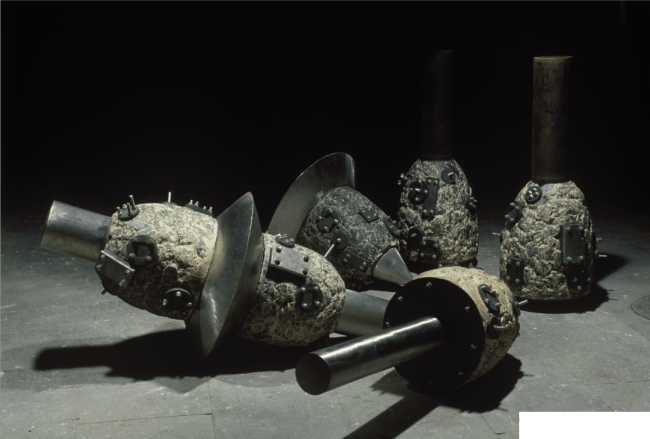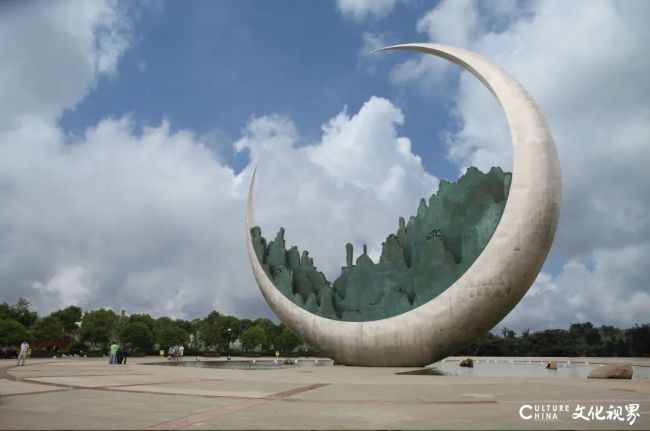After that, he created a number of monumental sculpture masterpieces, such as the bronze reliefs Jinggang Meeting and Red Capital Ruijin in Nanchang August 1 Square, On the Road to Guangchang at the north gate of the Soviet Area, and Sending Off the Husband to Join the Army, Looking Forward and Planting Planks and Dividing Land in Jinggang Martyrs Cemetery. At the turn of the century, he participated in the creation project of The Chinese People’s War of Resistance Against Japanese Aggression Memorial Group Sculpture and completed the design and creation of two groups of sculptures, Great Sword Majesty and Bullets and Bombs.
此后又创作出了一批纪念碑式的雕塑力作,如南昌八一广场青铜浮雕《井冈会师》《红都瑞金》、苏区北大门的《广昌路上》、井冈烈士陵园的《送郎参军》《盼》《插牌分田》等。世纪之交,他参与了《中国人民抗日战争纪念群雕》创作项目,完成了《大刀雄风》和《枪林弹雨》两组雕塑的设计创作。

Figure 3. Lv Pinchang. Space Program No.5. Metal and ceramic, 2006.
In terms of single-figure portrait creation the sculptor’s ability to depict characters is most evident, because not only is it necessary to achieve a resemblance but it is also necessary to explore the inner world of the characters through the shaping language. The images he created for the role models of the times, such as The Portrait of Fang Zhimin created for Fang Zhimin Cadre College in Jiangxi Province, The Portrait of Jiao YuLu created for Jiao YuLu Cadre College in Henan Province, The Portrait of Huang Wenxiu created for the “July 1st Medal” winners at Beijing Normal University, and The Portrait of Yuan Longping created for Yuan Longping, the father of hybrid rice, academician of the Chinese Academy of Engineering and recipient of the Republic Medal can all be be regarded as fine works of sculpture portraits. The difficulty lies in how to mobilize and give play to the artistic plasticity of sculpture on the basis of the character prototype, which seems easy but is full of generalization and exaggeration.
在单体人物肖像创作方面最见雕塑家形象刻画的功力,因为不仅要达到肖似,而且要通过塑造语言发掘人物的内心世界。他为时代楷模所塑造的形象,如为江西省方志敏干部学院创作的《方志敏像》,为河南省焦裕禄干部学院创作的《焦裕禄像》,为北京师范大学创作“七一勋章”获得者创作的《黄文秀像》和为杂交水稻之父、中国工程院院士、“共和国勋章”获得者袁隆平创作的《袁隆平像》等,都可谓雕塑肖像的精品,其难点在于人物原型上如何能够调动和发挥雕塑的艺术塑造性,看似平易却充满概括与夸张。
In fact, the generation of sculptors represented by Lv Pinchang was faced not only with the inheritance of monument sculpture, but also with the huge challenges posed by contemporary art in relation to traditional sculpture art. They were not satisfied with the creation of commemorative sculptures in the general sense, although this was already very difficult. Under the scourge and challenge of the contemporary visual culture trend, creating commemorative sculptures for history or public figures undoubtedly had publicity or field-specific characteristics, but also dissolued the independence of artists’ thinking and was more difficult to cope with during the rise of contemporary art in terms of thinking forms.
实际上,吕品昌这代雕塑艺术家面临的并不只是对纪念碑雕塑的传承,而是当代艺术对传统雕塑艺术形成的巨大挑战,他们并不满足于一般意义上的纪念雕塑创作,尽管这已经很难!在当代视觉文化大潮的冲刷以及挑战下,为历史或人物做纪念雕塑固然具有公共性或场域性,但也会消解艺术家思考的独立性,更难能应对思考形态的当代艺术的勃兴。

Figure 4. Lv Pinchang. Three Pure Reflections of the Moon. Bronze and stainless steel, 3200×460×23200cm, Shangrao city, Jiangxi province, 2010.
The most important artistic concept in contemporary art lies in how to show the activity and creativity of artists’ thinking by means of ready-made objects or all kinds of artistic media, so as to highlight artists’ ingenious use of media and the conceptual nature of “Tao in broken tiles”—exploring profound philosophical thinking from any ordinary object.
当代艺术最重要的艺术理念在于如何能够借助现成品或一切艺术媒介来展现艺术家思维的活跃与创造,以此凸显艺术家对媒介的巧思性的利用,以及“道在瓦甓”的观念性——从任何普通物品发掘出深刻的哲学思考。

Figure 5. Lv Pinchang. Bound Form No.3. Steel-jade porcelain, 66×45×32cm, 2016.